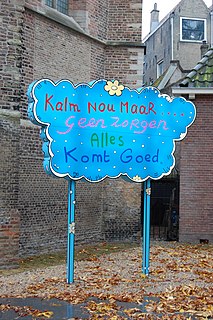Lukas Smits | |
|---|---|
| Born | 23 May 1935 |
| Nationality | Dutch |
| Education | Academy of Art and Design, Den Bosch Jan van Eyck Academy, Maastricht |
| Known for | Art |
| Movement | Schijt aan Schilderkunst (Bollocks to Painting, SAS), 1963 |
| Awards | Royal Subsidy for Painting, (1959), City of Maastricht Prize (1962), Royal Subsidy for Painting (1962), Travel grant, French government, (1964) |
Lukas Smits (born 23 May 1935 in Ravenswaaij) is a Dutch painter.
Lukas Smits was born in Ravenswaaij (Buren) and studied both at the Academy of Art and Design in Den Bosch and at the Jan van Eyck-Academy in Maastricht. In 1959 he received the Royal Subsidy for Painting, which was followed by the City of Maastricht Prize (1962), another Royal Subsidy for Painting (1962) and a travel grant from the French government (1964). Smits travelled to Spain, Italy (regularly), France, Mexico, the United States and Indonesia to complete his studies. He specialised as painter, collagist, draftsman, designer and sculptor. [1]
Among his works, non-figurative mixed media wall–paintings, glass mosaics, and wooden and metal sculptures can be seen with the number three as a constant element. Three is an important number for Smits, as it disposes the amount of different media mixed on the art work (three media), the parts in which the composition is divided (tripartite composition), and the physicality of the support (triptych). The subject-matter of Smits’ work explores the relationship between nature and culture. In this sense, he explored culture itself in a daily life context with the exhibition. [2]
Smits attempted with Ad Snijders and Johan Lennarts to bring art closer to people and make it more understandable.
Smits has worked as a lecturer at the Fine Arts Academy in Tilburg and has collaborated in environment projects. He has also been a member of the Brabantse Stichting voor Beeldende Kunst en Edelambacht and of the B.B.K. Amsterdam. Smits has displayed his work in the Barreira Galerry, Valencia, Spain and in the Loewy Galerie, Los Angeles, United States, in Arti en Amicitiae, Amsterdam and the Centre Cultureel, Toulousse, France (1986), in the Galerie Traject, Utrecht (1988), and in La Passarelle des Arts, Chambourcy, France (1999) and both the municipalities of Eindhoven and Amsterdam acquired work by him (Amsterdam possesses Z.W. Kwadraat’ 1977 and Schilderij’ 1978-’ 80). In addition, he has also participated in group exhibitions, being the most remarkable the following ones: the Stedelijk Museum Het Prinsenhof, Delft (1963), the Stedelijk Van Abbemuseum, Eindhoven (1963 and 1968), and the Museum Fodor, Amsterdam (1978–1979). Lukas Smits currently lives and works in Amsterdam and Kamerik.
Paul Panhuysen was a Dutch composer, visual and sound artist. He founded and directed Het Apollohuis, an art space that functioned during the 80's and 90's having artists doing sound installations, sound sculptures, and concerts about free improvisation, experimental music, and electronic music.
Per Kirkeby was a Danish painter, poet, film maker and sculptor.

The Van Abbemuseum is a museum of modern and contemporary art in central Eindhoven, Netherlands, on the east bank of the Dommel River. Established in 1936, the museum is named after its founder, Henri van Abbe, who loved modern art and wanted to enjoy it in Eindhoven. As of 2010, the collection of the museum housed more than 2700 works of art, of which about 1000 were on paper, 700 were paintings, and 1000 were sculptures, installations and video works.
Carel Balth was a Dutch artist and curator.

Jan Dibbets is an Amsterdam-based Dutch conceptual artist. His work is influenced by mathematics and works mainly with photography.

Roelof Frankot was a Dutch painter.

Cornelis "Kees" Bol was a Dutch painter and art educator. His work was exhibited in art galleries and museums throughout the Netherlands, as well as in Paris. In 1950 Bol was awarded the Thérèse van Duyl-Schwartze Prize and in 1982 he was made Knight in the Order of the Netherlands Lion.

Gerard Caris is a Dutch sculptor and artist who has pursued a single motif throughout the course of his artistic career, the pentagon.
Niek Kemps is a Dutch visual artist and lives and works in Amsterdam and Wenduine, Belgium.
Herman van den Boom is a Belgian photographer, artist, and designer.
Ad Snijders was born in Eindhoven in 1929. He was a painter, a collagist and a social activist.

Pieter Stoop is a Dutch painter of large abstract paintings.

Johan Lennarts (1932–1991-10-06) was a Dutch artist.
Jan Martens is a Dutch painter.

The Amsterdamse Joffers were a group of women artists in Amsterdam who met weekly in the last quarter of the 19th century to paint and show their works together. They were known for their style that followed the example of the Amsterdam Impressionists, and were all members of the Amsterdam artist societies Arti et Amicitiae and Sint Lucas, and most followed the lessons by professor August Allebé of the Rijksakademie van beeldende kunsten of Amsterdam.
René Daniëls is a Dutch artist.

Han Schuil is a Dutch multimedia artist, who works in a Dutch tradition of compactness and tension in painting.

Anthonie Wilhelmus (Toon) Verhoef is a Dutch painter, ceramist and art lecturer.

Lily van der Stokker is a Dutch visual artist. She is known for her colorful site-specific painted installations incorporating words and decorative motifs that reference social realities and power dynamics.
Jeroen Eisinga is a contemporary video artist from the Netherlands. His work is characterised by its performance like character and its plots where an ordeal is often central. Simplicity is of key importance to Eisinga. His work is shot on film and is shot on 16mm as well as on 35mm format film.